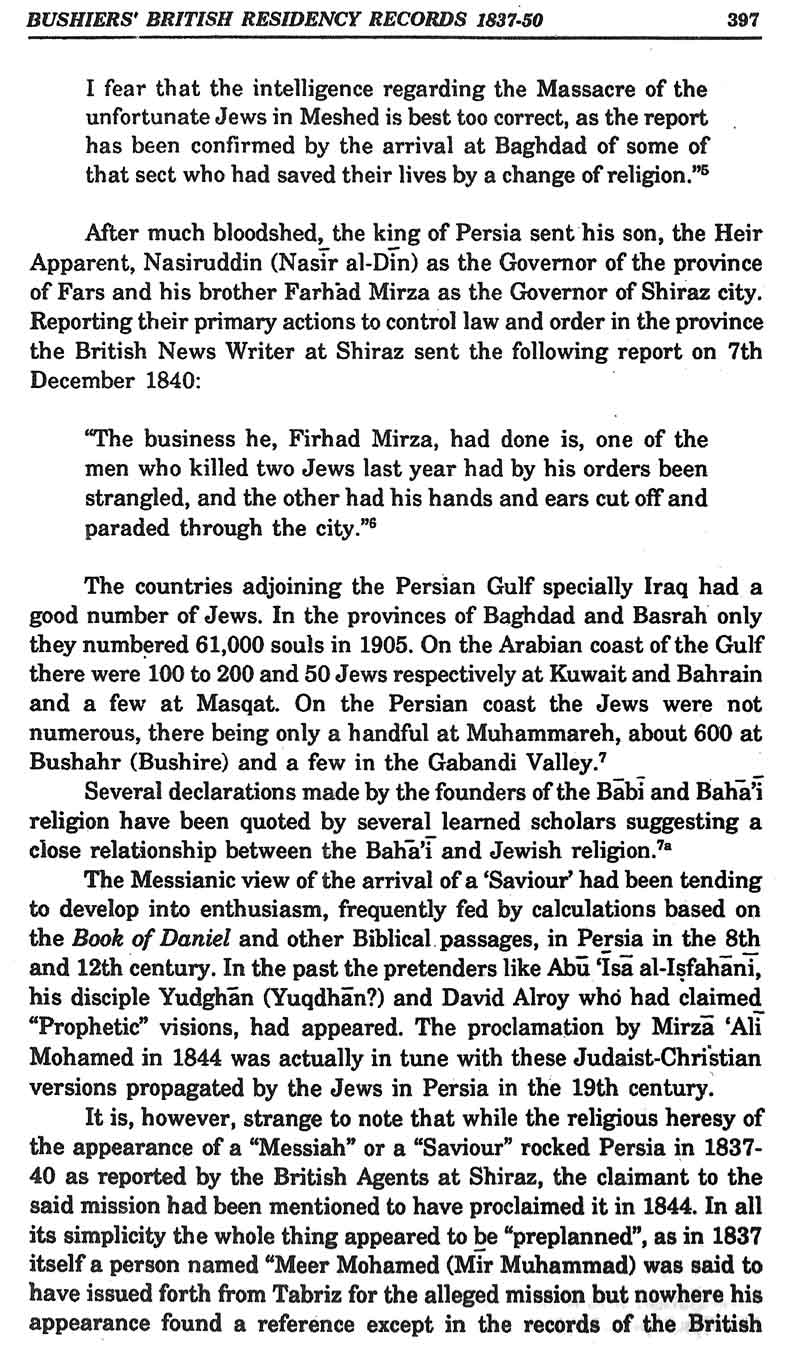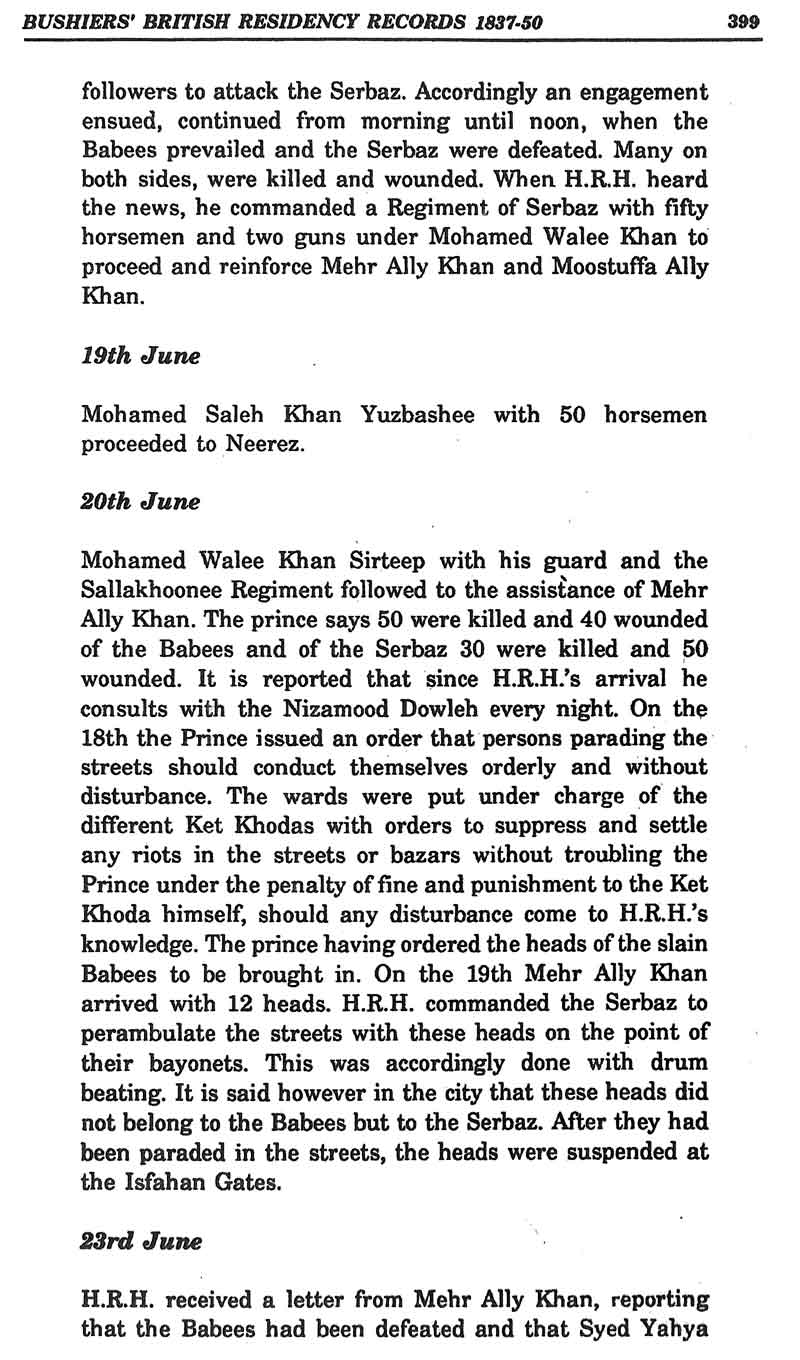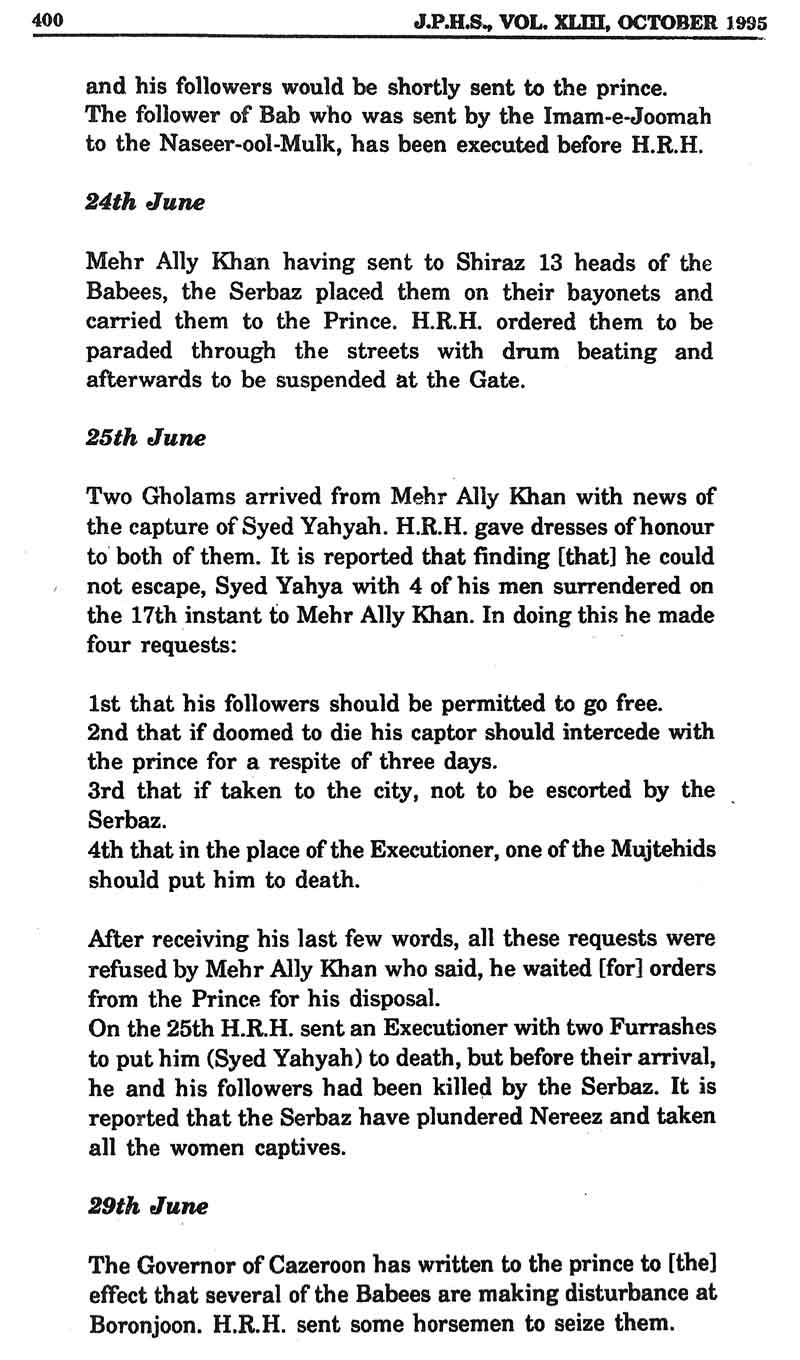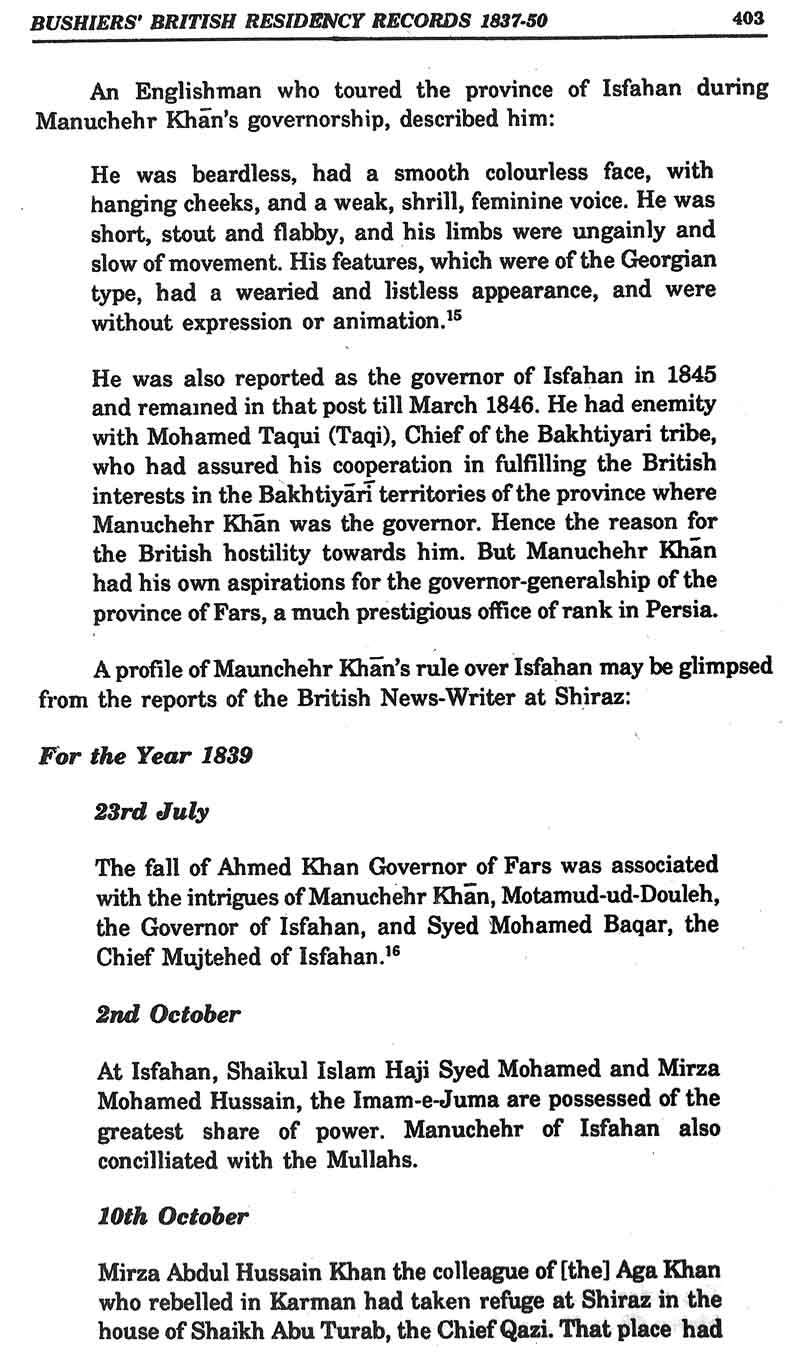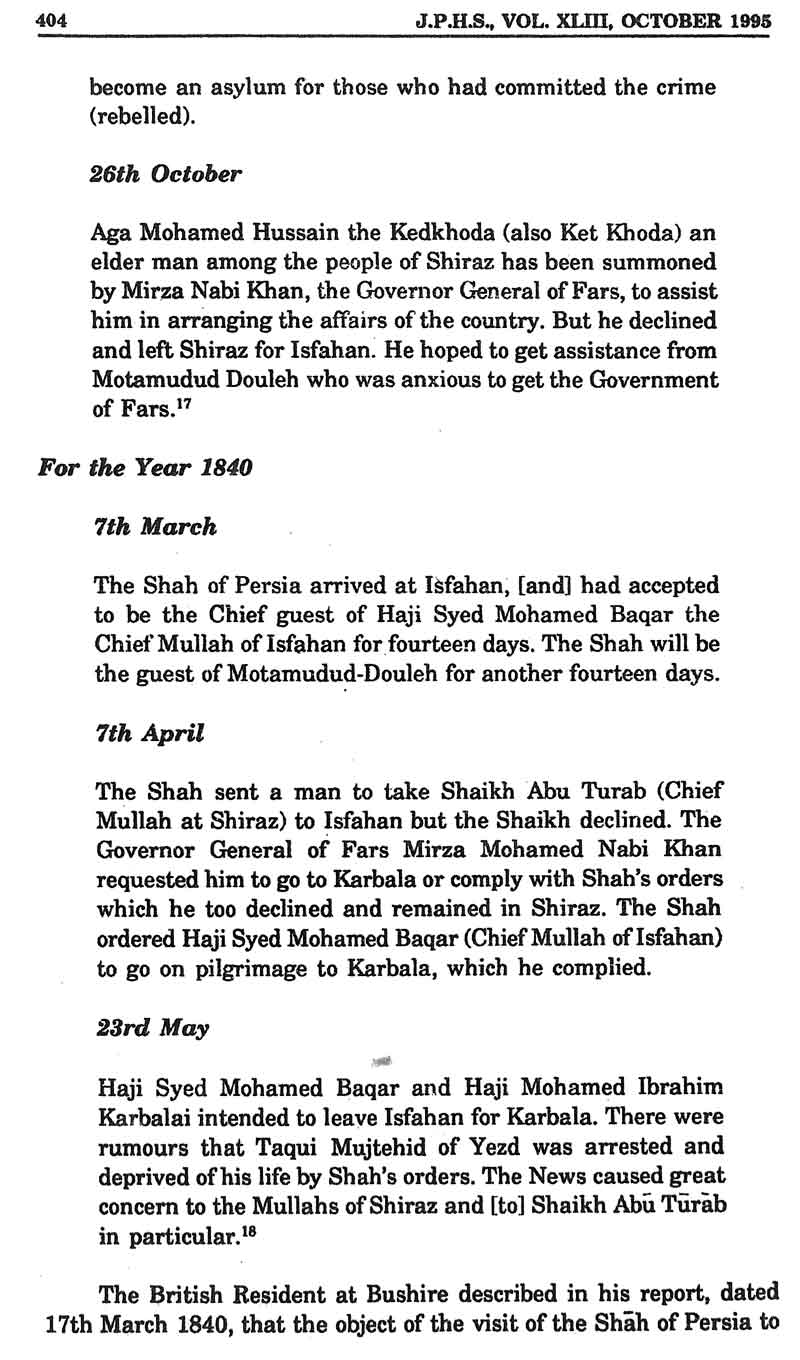
|
|
Abstract: Records from Mirza 'Ali Akbar, a British agent in Shiraz, from 1837, 1839, and 1850, with possible early mentions of the Báb. |
Bushires' British Residency Records (1837-50):
The Appearance of Babism in Persia
by Syed Shakeel Ahmed
published in Journal of the Pakistan Historical Society, 43:4, pages 395-4061995-10
1. About
"Bushires' British Residency Records (1837-50) (The appearance of Babism in Persia)" introduces records from the British Agent at Shiraz from the India Office Library and Records of a religious figure from Tabriz in 1837 as a possible early reference to the Bab during a period Amanat places the Bab in Bushire doing mercantile work visible in paperwork of the period. (See Amanat, Abbas (1989), Resurrection and renewal: the making of the Babi movement in Iran, 1844-1850," esp. pp. 121-131.) Ahmed next mentions 1839 reports out of Khorassan about a Torah prophecy for 1840 that, if it failed, would disrupt the Jewish population and that this circumstance provided an opportunity for the Bab to advance His claims. However Ahmed misses the coverage of the British Agents, Diplomatic notes, and newspaper coverage through most of 1845 of events related to the early phases of Babi history following the Bab's commission of the Letters of the Living. (See Moojan Momen (1981) The Bábí and Bahá'í religions 1844-1944: some contemporary western accounts.) Ahmed next focuses on 1850 reports mentioning the Bab or "Babees" (sic). Curiously Ahmed focuses on a report of a "Pomegranate Syrup" used by Babis to make people convert in conflict with forbidding intoxicating drugs. This is followed by trying to associate the Bab and Babis with politics in Isfahan in 1839-40. Though the accounts make no mention of the Bab or Babis, Ahmed claims other unstated/uncited "published material" makes the relationship clear. Ahmed then finishes with a short summary of claims of misdeeds of Babis from other papers, pointedly, from "Arab authors". - Steven Kolins2. Text
The commonly available information about the Bahai faith is that "The Bahá'í Religion was founded by Mirza Husayn 'Ali (1817-1892), known as Baha Allah. The faith was founded in 1844 by Mirza 'All Muhammad of Shiraz — known as the Bab or the Gate."1
The contemporary records of the British Residency at Bushire, however, give some unique information about the Babi faith in Persia. Mirza 'Ali Akbar, the British agent at Shiraz reported to the officiating Resident on 10th July 1837 (6th Rabi' al-Thani 1253 A.H.), the following intelligence:
"A person named Meer Mohamed has issued forth from near Tabreez and collected a body of followers. He has also proclaimed himself as commissioned from the High and represents himself to be the last of the Imams, one of his letters has reached Shiraz. Men are in doubts regarding him. As miracles he is stated to have made a dry tree green and a fountain to spring about after dry ground."2
A similar type of religious heresy occurred in Persia during 1254-55 A.H. (1840 A.D.) when Mirza Raza (Rada) offg. Agent at Shiraz, reported on 26th. October 1839 (17th Sha'biin 1254 A.H.):
"A moollah of Khorassan lately found a very old Towrat [Torah] and found that in it was predicted that during the present year viz. (A.H.) 1255, a prophet would make his appearance. This convinced the moollah that if no such occurrence took place, then must Mohamed [P.B.H.] be a true prophet and having assembled all the Jews told them that since their promised prophet came not they must confess the truth of Islamism and become true believers or otherwise suffer death. Since it was improper for Mohammedans to hold any intercourse with Infidels. During these days the Jews would not consent. The moollah went to the mosque and preached to the people telling them that this was "Hubad" [Jihad?] or Holy Warfare and that they must spil1 the blood of the Jews. The houses of these people were attacked and during one day and night all were killed. The moojtehid of Khorassan wrote to the moojtehid of Tehran telling him that if he followed the principles of the Koran he would do likewise and put all the Jews to death. It was in contemplation at Tehran to do this, but there the Jews have some influence, so they carried a present to Haji Meerza Aghassee who gave them shelter. The people afterwards tried to prevent the Jews drawing water, when Meerza Aghassee ordered that new wells should be dug solely for them. The Shah has ordered Meerza Massoud the Wuzeer for Foreign Affairs to confiscate the property of all the Jews in Khroassan."3
The Jewish Links
The above mentioned disturbances appear to be a repercussion of the stories spread by the Jews regarding the appearance of 'a prophet'. Was there any link between the proclamation of Meer Mohamed and the 'foretelling' said to have been mentioned in the Towrat (Torah)?
The religious heresy, which actually had been deeply enshrined in the old Persian tradition and which appeared again in the form of Babism (Bahá'íism at a latter date) related to the coming of the "Saviour" — The "Great King" or "Him Whom God shall make Manifest". Several Christian texts, based on Iranian traditions described the "Saviour's" miraculous birth. Similar influences on the postexilic Jewish religion were also described.4
It is to be noted again that the said heresy was rekindled by the alleged reference to the Towrat.
The reports of large scale persecutions of the Jews at Bhushire, Meshed, Khurasan, Tehran and Shiraz between the years 1838-40 indicated that the religious fervour was considerably behind these happenings. Mr. S. Hennell, British Resident of the Persian Gulf at Bushire reported to Mr. L.R. Reid, Acting Chief Secretary to Government of India, Bombay on 24th November 1839:
I fear that the intelligence regarding the Massacre of the unfortunate Jews in Meshed is best too correct, as the report has been confirmed by the arrival at Baghdad of some of that sect who had saved their lives by a change of religion."5
After much bloodshed, the king of Persia sent his son, the Heir Apparent, Nasiruddin (Nasir al-Din) as the Governor of the province of Fars and his brother Farhad Mirza as the Governor of Shiraz city. Reporting their primary actions to control law and order in the province the British News Writer at Shiraz sent the following report on 7th December 1840:
"The business he, Firhad Mirza, had done is, one of the men who killed two Jews last year had by his orders been strangled, and the other had his hands and ears cut off and paraded through the city."6
The countries adjoining the Persian Gulf specially Iraq had a good number of Jews. In the provinces of Baghdad and Basrah only they numbered 61,000 souls in 1905. On the Arabian coast of the Gulf there were 100 to 200 and 50 Jews respectively at Kuwait and Bahrain and a few at Masqat. On the Persian coast the Jews were not numerous, there being only a handful at Muhammareh, about 600 at Bushahr (Bushire) and a few in the Gabandi Valley.7
Several declarations made by the founders of the Babi and Bahá'í religion have been quoted by several learned scholars suggesting a close relationship between the Bahá'í and Jewish religion.7a
The Messianic view of the arrival of a 'Saviour' had been tending to develop into enthusiasm, frequently fed by calculations based on the Book of Daniel and other Biblical. passages, in Persia in the 8th and 12th century. In the past the pretenders like Abu 'Isa al-Isfahani, his disciple Yudghan (Yuqdhan?) and David Alroy who had claimed "Prophetic" visions, had appeared. The proclamation by Mirza 'Ali Mohamed in 1844 was actually in tune with these Judaist-Christian versions propagated by the Jews in Persia in the 19th century.
It is, however, strange to note that while the religious heresy of the appearance of a "Messiah" or a "Saviour" rocked Persia in 1837-40 as reported by the British Agents at Shiraz, the claimant to the said mission had been mentioned to have proclaimed it in 1844. In all its simplicity the whole thing appeared to be "preplanned", as in 1837 itself a person named Meer Mohamed (Mir Muhammad) was said to have issued forth from Tabriz for the alleged mission but nowhere his appearance found a reference except in the records of the British Residency at Bushire, which has remained untold upto this time. It is believed that since the said "appearance" and "proclamation" coincided with the current controversy between the Jews and Shi'ite theologians in 1837-40, a latter date i.e., 1844, was selected for Mirza 'Ali Mohamed to proclaim himself the Bab or (the Gate). It is more likely that the Meer Mohamed of 1837 and Mirza 'Ali Mohamed of 1844 were the same person. It is yet more strange that there was no mention of any person claiming the "Savior's Mission" in the Records of the Residency in 1844 and till 1850 there were no references to even Mirza 'Ali Mohamed and Babism in the said records.
The Persecution of 1850
The day to day reports of the occurrences in the Persian province of Fars and its capital city, Shiraz, in 1850 were unusually described, despatched and detailed by the Agent and the Resident of the British Residency of the Persian Gulf at Bushire. The unprecedented coverage was not seen during the massacre of the Jews of Persia in 1837-40. Even the movements of the Isma'ili imam, the Aga Khan, had not found so much coverage and interest in the British Residency in the previous years. It was, however, surprising that, during the whole year of 1850, the British ambassador at Tehran, Mr. Justin Sheil, was busy in settling an issue of a "Golden Watch" said to have been misappropriated by Mirza Mohamed, the British Agent at Shiraz.
A chronological statement of the events in 1850 reported by the British Agent at Shiraz regarding the Babees (Babis) is given below:
29th April
A disciple of Mirza Ally Mohamed the Bah has been seized by the people of Sheikh Aboo Torah and sent by him to Naseerool Mulk. Sheik Mehdy the Moojtehid has given a Fatweh for his execution. At present he is a prisoner in the house of the Nazimool Mulk.
18th June
Information has now been received that the followers of Bab made a night attack upon the Serbaz and killed and wounded several. The next day Moostufta Gooly Khan Sirteep commanded the Serbaz to attack and take the Babees and to destroy the tower in which was Syed Yahyah.
The latter, on hearing this, came out and ordered the followers to attack the Serbaz. Accordingly an engagement ensued, continued from morning until noon, when the Babees prevailed and the Serbaz were defeated. Many on both sides, were killed and wounded. When H.R.H. heard the news, he commanded a Regiment of Serbaz with fifty horsemen and two guns under Mohamed Walee Khan to proceed and reinforce Mehr Ally Khan and Moostuffa Ally Khan.
19th June
Mohamed Saleh Khan Yuzbashee with 50 horsemen proceeded to Neerez.
20th June
Mohamed Walee Khan Sirteep with his guard and the Sallakhoonee Regiment followed to the assistance of Mehr Ally Khan. The prince says 50 were killed and 40 wounded of the Babees and of the Serbaz 30 were killed and 50 wounded. It is reported that since H.R.H.'s arrival he consults with the Nizamood Dowleh every night. On the 18th the Prince issued an order that persons parading the streets should conduct themselves orderly and without disturbance. The wards were put under charge of the different Ket Khodas with orders to suppress and settle any riots in the streets or bazars without troubling the Prince under the penalty of fine and punishment to the Ket Khoda himself, should any disturbance come to H.R.H.'s knowledge. The prince having ordered the heads of the slain Babees to be brought in. On the 19th Mehr Ally Khan arrived with 12 heads. H.R.H. commanded the Serbaz to perambulate the streets with these heads on the point of their bayonets. This was accordingly done with drum beating. It is said however in the city that these heads did not belong to the Babees but to the Serbaz. After they had been paraded in the streets, the heads were suspended at the Isfahan Gates.
23rd June
H.R.H. received a letter from Mehr Ally Khan, reporting that the Babees had been defeated and that Syed Yahya and his followers would be shortly sent to the prince.
The follower of Bab who was sent by the Imam-e-Joomah to the Naseer-ool-Mulk, has been executed before H.R.H.
24th June
Mehr Ally Khan having sent to Shiraz 13 heads of the Babees, the Serbaz placed them on their bayonets and carried them to the Prince. H.R.H. ordered them to be paraded through the streets with drum beating and afterwards to be suspended at the Gate.
25th June
Two Gholams arrived from Mehr Ally Khan with news of the capture of Syed Yahyah. H.R.H. gave dresses of honour to both of them. It is reported that finding [that] he could not escape, Syed Yahya with 4 of his men surrendered on the 17th instant to Mehr Ally Khan. In doing this he made four requests:
1st that his followers should be permitted to go free.
2nd that if doomed to die his captor should intercede with the prince for a respite of three days.
3rd that if taken to the city, not to be escorted by the Serbaz.
4th that in the place of the Executioner, one of the Mujtehids should put him to death.
After receiving his last few words, all these requests were refused by Mehr Ally Khan who said, he waited [for] orders from the Prince for his disposal.
On the 25th H.R.H. sent an Executioner with two Furrashes to put him (Syed Yahyah) to death, but before their arrival, he and his followers had been killed by the Serbaz. It is reported that the Serbaz have plundered Nereez and taken all the women captives.
29th June
The Governor of Cazeroon has written to the prince to [the] effect that several of the Babees are making disturbance at Boronjoon. H.R.H. sent some horsemen to seize them.
8th July
Mehr Ally Khan sent to H.R.H. eleven followers of Bab, they have all been imprisoned.
10th July
Mehr Ally Khan and Moostuffa Ghoolee Khan, who had been sent against Syed Yahyah have returned to Shiraz bringing with them 25 of the Babee Sect together with the head of Syed Yahya and 13 others as an offering to H.R.H. who ordered the prisoners to be confined. The Prince has received these two Khans with great favour. It appears that only one mahala of Nereez was plundered and destroyed. The Serbaz had with them a good quantity of the stolen goods. Syed Yahya is reported to have four or five vessels of Pomegranate Syrup, a single drop of which was sufficient to make a man become a Babee and join him. One bottle was drunk by four Serbaz who instantly turned Babees and fought against their own commanders. They say this Syrup has been brought to the Prince.
20th August
H.R.H. summoned 10 Babee prisoners and commanded them either to curse Syed Yahya or to suffer death. As they remained silent, it was concluded they were steadfast in their faith. The Prince however respited them for an hour, when they submitted to H.R.H.'s will. Some persons then interceded for them and the Prince forgave them.
21st August
The Prince has been rather unwell for some days past on which account it is said he will release all the imprisoned Babees.
6th October
Two Babees were delivered over by Mehr Ally Khan to H.R.H. one of them was the Executioner and the other a Sirdar of Syed Yahyah, both were beheaded.9
The details of the executions given above have been minutely recorded but it is conspicuous that on 9th July 1850, the date of the execution of the Bab, Mirza 'Ali Mohamed, nothing was related by the British Agent at Shiraz.
The curious "Pomegranate Syrup" which was used as "Nectar" and had the miraculous "effect" is said to be extracted from "a large fruit containing many red seeds."10
Pomegranate: The several celled angular berry of a tropical African and Asiatic tree (Punica Granatum) that is about the size of an orange, contains many seeds in a crimson acid pulp which is eaten raw or made into a beverage and has a thick astringent rind used especially formerly in medicine and tanning. and together with the flowers of the tree as the source of a red dye.11
About the qualities of the beverage it was said: "A dark red that is yellower and slightly darker and less strong than cranberry (Vaccinium Oxyeoccos) and yellower, lighter, and stronger than average garnet or average wine."12
It is strange that a religion, whose founder claimed to have advanced the theory of progressiveness of revelation and forbade the use of intoxicating liquors and drugs, should be associated in its very beginning with intoxicants. Perhaps the progressive derivation of the meaning of revelation was not possible without that usage.
Political Affairs
Some Arab authors have highlighted the connections between Mirza 'Ali Mohamed and Manuchehr Khan, the Governor of lsfahan.13
The author of the Persian Gulf Gazetteer wrote in 1914 about Manuchehr Khan:
In 1839 Manuchehr Khan, better known as Motamad-uDouleh, a Georgian of Christian parentage but reared as a Mohammedan slave, was appointed by the Persian Government, probably under Russian influence, to be Governor of Isfahan, Luristan and Arabistan. This able but tyrannical official who like Agha Muhammad Khan, the ferocious founder of the Qajar Dynasty, cruelly felt* [sic; *Perhaps dealt. -ed.] throughout the length and breadth of the provinces assigned to him. His policy was clear and consistent, but bad faith was its principal instrument, and he revelled in the invention and infliction of appalling tortures.14
An Englishman who toured the province of Isfahan during Manuchehr Khan's governorship, described him:
He was beardless, had a smooth colourless face, with hanging cheeks, and a weak, shrill, feminine voice. He was short, stout and flabby, and his limbs were ungainly and slow of movement. His features, which were of the Georgian type, had a wearied and listless appearance, and were without expression or animation.15
He was also reported as the governor of Isfahan in 1845 and remained in that post till March 1846. He had enmity with Mohamed Taqui (Taqi), Chief of the Bakhtiyari tribe, who had assured his cooperation in fulfilling the British interests in the Bakhtiyarl territories of the province where Manuchehr Khan was the governor. Hence the reason for the British hostility towards him. But Manuchehr Khan had his own aspirations for the governor-generalship of the province of Fars, a much prestigious office of rank in Persia.
A profile of Manuchehr Khan's rule over Isfahan may be glimpsed from the reports of the British News-Writer at Shiraz:
For the Year 1839
23rd July
The fall of Ahmed Khan Governor of Fars was associated with the intrigues of Manuchehr Khan, Motamud-ud-Douleh, the Governor of Isfahan, and Syed Mohamed Baqar, the Chief Mujtehed of Isfahan.16
2nd October
At Isfahan, Shaikul Islam Haji Syed Mohamed and Mirza Mohamed Hussain, the Imam-e-Juma are possessed of the greatest share of power. Manuchehr of Isfahan also concilliated with the Mullahs.
10th October
Mirza Abdul Hussain Khan the colleague of [the] Aga Khan who rebelled in Karman had taken refuge at Shiraz in·the house of Shaikh Abu Turab, the Chief Qazi. That place had become an asylum for those who had committed the crime (rebelled).
26th October
Aga Mohamed Hussain the Kedkhoda (also Ket Khoda) an elder man among the people of Shiraz has been summoned by Mir.za Nabi Khan, the Governor General of Fars, to assist him in arranging the affairs of the country. But he declined and left Shiraz for Isfahan. He hoped to get assistance from Motamudud Douleh who was anxious to get the Government of Fars.17
For the Year 1840
7th March
The Shah of Persia arrived at Isfahan, [and] had accepted to be the Chief guest of Haji Syed Mohamed Baqar the Chief Mullah of Isfahan for fourteen days. The Shah will be the guest of Motamudud-Douleh for another fourteen days.
7th April
The Shah sent a man to take Shaikh Abu Turab (Chief Mullah at Shiraz) to Isfahan but the Shaikh declined. The Governor General of Fars Mirza Mohamed Nabi Khan requested him to go to Karbala or comply with Shah's orders which he too declined and remained in Shiraz. The Shah ordered Haji Syed Mohamed Baqar (Chief Mullah of Isfahan) to go on pilgrimage to Karbala, which he complied.
23rd May
Haji Syed Mohamed Baqar and Haji Mohamed Ibrahim Karbalai intended to leave Isfahan for Karbala. There were rumours that Taqui Mujtehid of Yezd was arrested and deprived of his life by Shah's orders. The News caused great concern to the Mullahs of Shiraz and [to] Shaikh Abu Turab in particular.18
The British Resident at Bushire described in his report, dated 17th March 1840, that the object of the visit of the Shah of Persia to Isfahan was the punishment of the ringleaders concerned in the late riots in Kashan.19
Another report of the British Resident dated 14th April 1840, stated that rumours of putting to death a member of the turbulent characters of Isfahan and exacting a fine of 30,000 Tomans from the individuals connected with the priesthood of the place. It also stated that the Shah's pre-condition for visiting Shiraz, was that Shaikh Abu Turab should at first be sent to Isfahan, but it was not yet complied with.20
The strife at Shiraz, the capital of the largest province of Persia (Fars) and the involvement of the religious personalities was so manifest that the News Agent reported:
A religious personality had foretold the replacement of the Governor of Fars and [the) conquering [of] Iran by [the] English.21
The war between Britain and Persia took place in 1856-57, but its preparations were already underway even in 1839. The evacuation of British Residency from Bushire to Khorag in 1839 was caused by the scuffle between the Shroff of the residency (a Jew who had a private business of selling illicit wine at Bushire) and the public of Bushire, but the Resident at a latter date mentioned that the evacuation of the Residency helped in diverting the attention of the Shah of Persia from Herat.
The reports of the British News Agent, of the years 1839, 1849 given above nowhere mentioned the involvement of the "Babees" in the affairs but a comparison with the published material, prove otherwise. The report about Taqui Mujtahid was dated 23rd May 1840. The lady named Tahirah, daughter of Mullah Saleh Barkani who was the earliest converts of Babism (later Bahá'í-ism) and about whom Martha Room had written a book entitled Tahirah the pure, Iran's greatest woman and who was called in dedication and love as "Qurratu'l-Ain" (Qurrat al-'Ayn, The Coolness of Eyes) or "Zarrin Taj" (meaning "The Golden Crown") was said to be involved in the murder of her uncle by the orders of the Shah of Persia.22
The said lady played an important role in the spread of Babism and the notorious Qadi of Shiraz about whom the reports cited above spoke so openly, was also playing in the hands of the "Bab". But the name of Shaykh Abu Turab given in the list of the famous disciples of Mirza 'Ali Mohamed was not surprising.23
The perspective reporting of events in 1839-40 also indicated that the appearance of the founder of Babism had an earlier date. He might have gone into "hiding" after his first appearance in 1837 as reported earlier and could have claimed to be the Bab at a later date in 1844.
The competition between the Russians and the British to enhance their interests in Persia in the middle of the 19th century is too well known. The appearance of the Aga Khan and Mirza 'Ali Mohamed in those crucial days was not merely a coincidence. Persia might be a controversial issue as reported by J.G. Lorimer, but clearly indicated that a Russian and Jewish connection was surely there behind the Babis of Persia.
-
1. Encyclopedia Britannica, see under "Bahai Faith", p. 587.
2. India Office Library and Records, hence IOR, British Political Residency, Bushire, File No. R/15/l/75 of 1837, pp. 131-133.
3. IOR, British Political Residency, Bushire, File No. R/15/l/85 of 1839-40, pp. 109-114, 111-116.
4. Encyclopedia Britanica, see under "Iranian Religions", p. 872.
5. IOR, Political Residency, Bushire, File No. R/15/l/80 of 1839, pp. 471, 555. File Nos. R/15/l/76, 78, 79, pp. 37, 56, 67, 119 have also reports of cases of assaults on Jewish people.
6. Ibid., File No. R/15/1191 of 1840, p. 80.
7. J.G. Lorimer, Gazetteer of the Persian Gulf, vol. 1, Part 2, p. 2381.
7a. Muhsin Abdul Hameed, Haqeequa Al-Babia wa'l Bahaiah, chapter X. pp. 187- 191.
8. Encyclopedia Britanica, see under "Messiah and Messianic movements", pp. 1018-1020.
9. IOR, Records of the British Political Residency at Bushire, File No. R/15/11121 of 1850, pp. 104, 151, 152, 153, 154, 155, 158, 165, 166, 226, 228, 284.
10. Michael West, The New Method English Dictionary.
11. Webster's third New International Dictionary.
12. Ibid.
13. Abdul Mutaal Al-Suaeedi, Al-Mujaddadun fi'l Islam, p. 500.
Muhsin Abdul Hameed, Haqeequn Al-Babia Wa'l Bahaiah, p. 100.
Dairatal Maarifal Islamia, see under Bab, p. 501.
14. The Gazetteer of the Persian Gulf, p. 1657.
15. Sir A.H. Layard, Early Adventures, vol. 1, p. 313.
16. IOR, British Residency's file No. R/15/1/105, pp. 429, 430.
16. Ibid., File No. R/15/l/80 of 1839, pp. 249-252.
17. Ibid., File No. R/15/1185 of 1839-40, pp. 62-66, 75·80, 109-114.
18. Ibid., File No. R/15/1/85, 1839, 40, pp. 176-178, 215-217, 227-229.
19. Ibid., File No. R/15/l/87 of 1840, pp. 143, 144.
20. Ibid., File No. R/15/l/84 of 1R40, pp. 229, 230.
21. Ibid., File No. R/15/l/79 of 1839, pp. 245-251.
22. Dairatul Maarif al-Islamia under the title "Bab", p. 501.
23. Mohsin Abdul Hameed, Haqeequa Al-Babia Wa'l Bahaiah, p. 48.
3. Image scans (click for larger images)
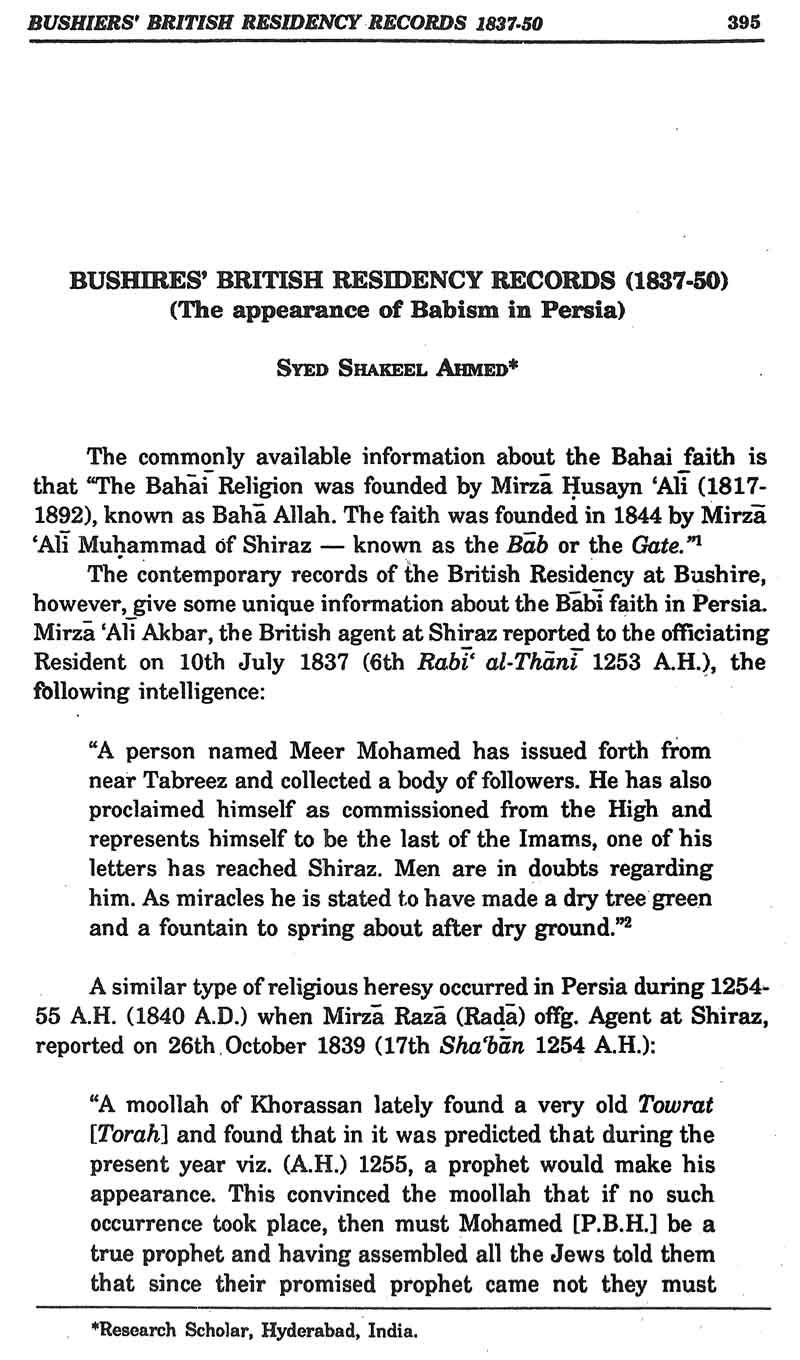
|
|

